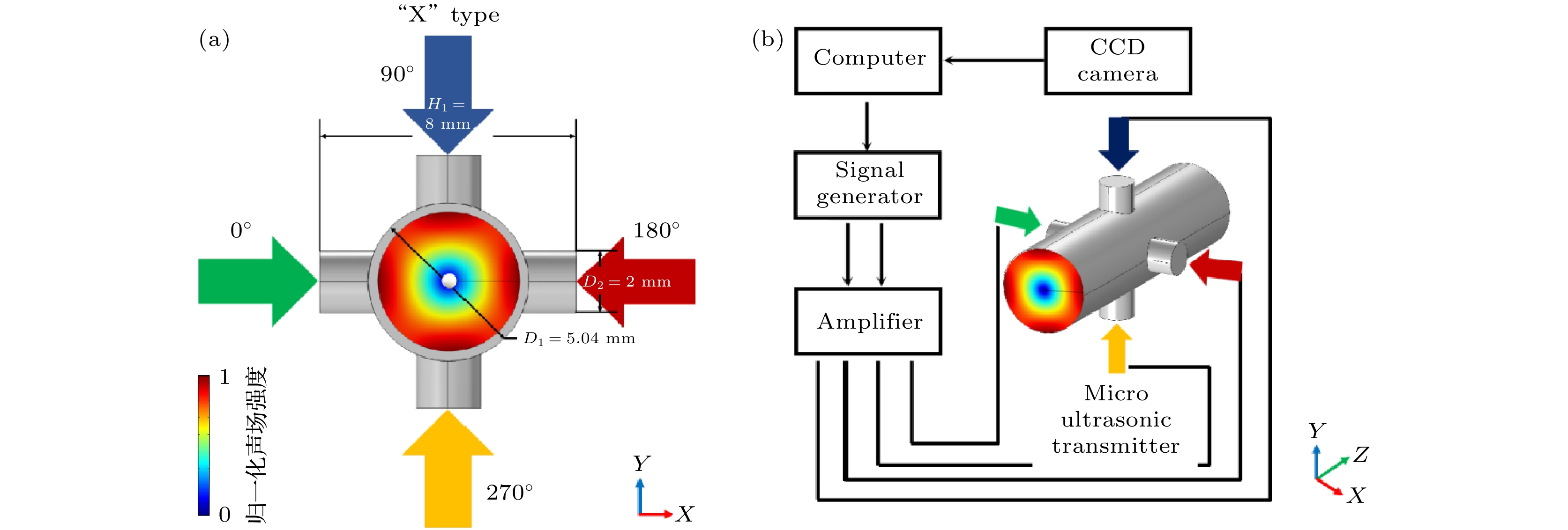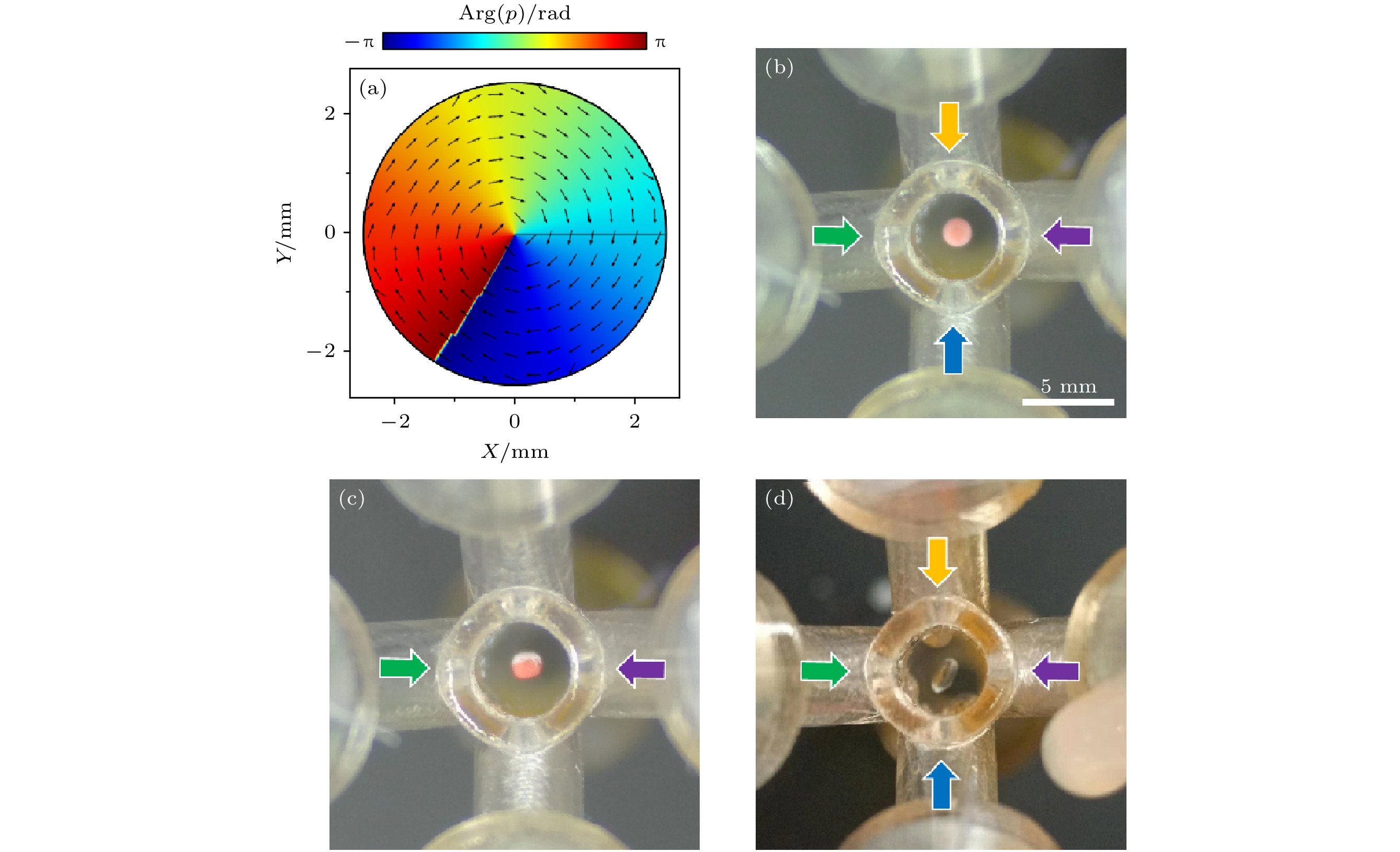-
The nonlinear propagation of acoustic waves in a medium generates acoustic radiation force. Using acoustic radiation force, particles and liquid droplets in gases can be levitated and manipulated. Acoustic levitation techniques can manipulate larger objects in the medium without contact, and therefore have been widely used in chemical analysis, droplet dynamics, and bioreactors. The acoustic levitation researches mainly focus on manipulating particles and droplets in an open environment, which provides flexibility in its use. However, this approach has limitations in terms of its efficiency in utilizing acoustic field energy. In this work we propose a concept of subwavelength pipe-enhanced acoustic tweezers, in which the acoustic field is used to manipulate expanded polystyrene particles (EPS) and droplets inside an acoustic pipe with an inner diameter smaller than the wavelength. In this work, we use four small transducers to excite a single low-order mode of a circular waveguide and its simplex state, and we also use the vortex sound field generated inside the waveguide to levitate and manipulate expanded polystyrene particle and droplet in the air. Compared with previous work in an open environment, we significantly enhance the acoustic radiation force by means of the acoustic resonance effect of the subwavelength duct, with both radial and axial suspension force magnitude increasing considerably. Similar concepts of subwavelength optical waveguides and resonant cavities and their effectiveness were already well known and widely used in the field of optics. In this work we first explain theoretically the basis for the design of subwavelength pipe-enhanced acoustic tweezer dimensions. Then, we point out in simulation that the pipe-enhanced acoustic tweezers, compared with the open environment acoustic tweezers, have strong sound field gradient distribution and acoustic radiation force distribution in the pipe. This conclusion is demonstrated experimentally. Finally, the manipulation of droplet and particle levitation and rotation in subwavelength-pipe-enhanced acoustic tweezers is systematically carried out. In this work we introduce the concept of subwavelength acoustic pipe for acoustic manipulation, which is expected to deepen the physical understanding of the interaction between acoustic fields and matter, and to develop new miniaturized acoustic manipulation devices for levitating particles and droplets.
-
Keywords:
- acoustic radiation force /
- acoustic control /
- subwavelength cross pipe
[1] Brandt E H 2001 Nature 413 474
 Google Scholar
Google Scholar
[2] Wu J 1991 J. Acoust. l Soc. Am. 89 2140
 Google Scholar
Google Scholar
[3] 朱纪霖, 高东宝, 曾新吾 2021 70 214302
 Google Scholar
Google Scholar
Zhu J L, Gao D B, Zeng X W 2021 Acta Phys. Sin. 70 214302
 Google Scholar
Google Scholar
[4] Xie W J, Cao C D, Lü Y J, Hong Z Y, Wei B 2006 Appl. Phys. Lett. 89 214102
 Google Scholar
Google Scholar
[5] 齐绍富, 蔡飞燕, 田振, 黄先玉, 周娟, 王金萍, 李文成, 郑海荣, 邓科 2023 72 024301
 Google Scholar
Google Scholar
Qi S F, Cai F Y, Tian Z, Huang X Y, Zhou J, Wang J P, Li W C, Zheng H R, Deng K 2023 Acta Phys. Sin. 72 024301
 Google Scholar
Google Scholar
[6] Ozcelik A, Rufo J, Guo F, Gu Y, Li P, Lata J, Huang T J 2018 Nat. Methods 15 1021
 Google Scholar
Google Scholar
[7] Santesson S, Nilsson S 2004 Anal. Bioanal. Chem. 378 1704
 Google Scholar
Google Scholar
[8] Jin H, Wang W, Liu F, Yu Z, Chang H, Li K, Gong J 2017 Int. J. Multiphase Flow 94 44
 Google Scholar
Google Scholar
[9] Foresti D, Poulikakos D 2014 Phys. Rev. Lett. 112 024301
 Google Scholar
Google Scholar
[10] Bouyer C, Chen P, Güven S, Demirtaş T T, Nieland T J F, Padilla F, Demirci U 2016 Adv. Mater. 28 161
 Google Scholar
Google Scholar
[11] Zhang R, Guo H, Deng W, Huang X, Li F, Lu J, Liu Z 2020 Appl. Phys. Lett. 116 123503
 Google Scholar
Google Scholar
[12] Ahmed D, Ozcelik A, Bojanala N, Nama N, Upadhyay A, Chen Y, Hanna-Rose W, Huang T J 2016 Nat. Commun. 7 11085
 Google Scholar
Google Scholar
[13] Priego-Capote F, de Castro L 2006 TrAC Trends Anal. Chem. 25 856
 Google Scholar
Google Scholar
[14] Xie W J, Cao C D, Lu Y J, Wei B 2002 Phys. Rev. Lett. 89 104304
 Google Scholar
Google Scholar
[15] Nordine P C, Merkley D, Sickel J, Finkelman S, Telle R, Kaiser A, Prieler R 2012 Rev. Sci. Instrum. 83 125107
 Google Scholar
Google Scholar
[16] Yan N, Hong Z Y, Geng D L, Wei B 2015 Appl. Phys. A 120 207
 Google Scholar
Google Scholar
[17] Anilkumar A V, Lee C P, Wang T G 1993 Phy. Fluids A:Fluid Dyn. 5 2763
 Google Scholar
Google Scholar
[18] Hong Z Y, Yin J F, Zhai W, Yan N, Wang W L, Zhang J, Drinkwater B W 2017 Sci. Rep. 7 7093
 Google Scholar
Google Scholar
[19] Liu P, Li H, Zhou Z, Pei Y 2022 Appl. Phys. Lett. 120 222202
 Google Scholar
Google Scholar
[20] Watanabe A, Hasegawa K, Abe Y 2018 Sci. Rep. 8 10221
 Google Scholar
Google Scholar
[21] 李鑫鹏, 曹睿杰, 李铭, 郭各朴, 李禹志, 马青玉 2022 71 204304
 Google Scholar
Google Scholar
Li X P, Cao R J, Li M, Guo G P, Li Y Z, Ma Q Y 2022 Acta Phys. Sin. 71 204304
 Google Scholar
Google Scholar
[22] 陈心成 2019 硕士学位论文 (武汉: 华中科技大学)
Chen X C 2019 M. S. Thesis (Wuhan: Huazhong University of Science and Technology) (in Chinese)
[23] Gor’kov L P 1962 Sov. Phys. Dokl. 6 773
-
图 1 亚波长管道增强型空气声镊 (a) 亚波长管道增强型空气声镊的尺寸, D1是管内壁内径, D2是超声入射通道直径, H1是超声入射通道的长度; (b) 亚波长管道增强型空气声镊操控实验示意图
Figure 1. Subwavelength pipe-enhanced acoustic air tweezers: (a) Dimension of subwavelength pipe-enhanced acoustic air tweezers, D1 is the inner diameter of the tube wall, D2 is the diameter of the ultrasonic incidence channel, and H1 is the length of the ultrasonic incidence channel; (b) schematic diagram of subwavelength pipe-enhanced acoustic air tweezers manipulation experiment.
图 2 开放环境型声镊和亚波长管道增强型的声镊声场和声辐射力分布 (a)开放环境型声镊XY截面上声场强度分布; (b) 开放环境型声镊ZY截面上声场强度分布; (c) 亚波长管道增强型声镊XY截面上声场强度分布; (d) 亚波长管道增强型声镊ZY截面上声场强度分布; (e) 2种声镊在X轴上的声辐射力X分量分布; (f) 2种声镊在Z轴上的声辐射力Z分量分布
Figure 2. Sound field and acoustic radiation force distributions of open environment tweezers and subwavelength pipe-enhanced tweezers: (a) Sound field intensity distribution on XY cross-section of open environment tweezers; (b) sound field intensity distribution on ZY cross-section of open environment tweezers; (c) sound field intensity distribution on XY cross-section of subwavelength pipe-enhanced tweezers; (d) sound field intensity distribution on ZY cross-section of subwavelength pipe-enhanced tweezers; (e) X-component distribution of acoustic radiation force on X-axis of both tweezers; (f) Z-component distribution of acoustic radiation force on Z-axis of both tweezers.
图 4 亚波长管道增强型声镊微粒和液滴操控实验结果 (a) 亚波长管道增强型声镊相位分布图; (b)控制EPS小球旋转运动的效果图; (c)控制EPS小球静止悬浮的效果图; (d)悬浮液滴的效果图
Figure 4. Experimental results of particle and droplet manipulation with subwavelength pipe-enhanced acoustic tweezers: (a) Phase distribution of subwavelength pipe-enhanced acoustic tweezers; (b) effect of controlling rotational motion of EPS spheres; (c) effect of controlling static suspension of EPS spheres; (d) effect of suspending droplet.
图 5 EPS小球旋转情况 (a)使用高速CCD相机拍摄EPS小球旋转; (b) EPS小球旋转角度和时间的关系; (c) EPS小球旋转速度和换能器驱动电压的关系
Figure 5. Rotation of EPS ball: (a) Photograph of EPS ball rotating obtained by high-speed CCD camera; (b) relationship between time and rotation angle of EPS ball; (c) relationship between rotation speed of EPS ball and driving voltage of transducer.
表 1 材料声学参数
Table 1. Material acoustic parameters.
参数 空气 发泡塑料 密度/(kg·m–3) 1.29 100 纵波声速/(m·s–1) 343 820 横波声速/(m·s–1) 550 -
[1] Brandt E H 2001 Nature 413 474
 Google Scholar
Google Scholar
[2] Wu J 1991 J. Acoust. l Soc. Am. 89 2140
 Google Scholar
Google Scholar
[3] 朱纪霖, 高东宝, 曾新吾 2021 70 214302
 Google Scholar
Google Scholar
Zhu J L, Gao D B, Zeng X W 2021 Acta Phys. Sin. 70 214302
 Google Scholar
Google Scholar
[4] Xie W J, Cao C D, Lü Y J, Hong Z Y, Wei B 2006 Appl. Phys. Lett. 89 214102
 Google Scholar
Google Scholar
[5] 齐绍富, 蔡飞燕, 田振, 黄先玉, 周娟, 王金萍, 李文成, 郑海荣, 邓科 2023 72 024301
 Google Scholar
Google Scholar
Qi S F, Cai F Y, Tian Z, Huang X Y, Zhou J, Wang J P, Li W C, Zheng H R, Deng K 2023 Acta Phys. Sin. 72 024301
 Google Scholar
Google Scholar
[6] Ozcelik A, Rufo J, Guo F, Gu Y, Li P, Lata J, Huang T J 2018 Nat. Methods 15 1021
 Google Scholar
Google Scholar
[7] Santesson S, Nilsson S 2004 Anal. Bioanal. Chem. 378 1704
 Google Scholar
Google Scholar
[8] Jin H, Wang W, Liu F, Yu Z, Chang H, Li K, Gong J 2017 Int. J. Multiphase Flow 94 44
 Google Scholar
Google Scholar
[9] Foresti D, Poulikakos D 2014 Phys. Rev. Lett. 112 024301
 Google Scholar
Google Scholar
[10] Bouyer C, Chen P, Güven S, Demirtaş T T, Nieland T J F, Padilla F, Demirci U 2016 Adv. Mater. 28 161
 Google Scholar
Google Scholar
[11] Zhang R, Guo H, Deng W, Huang X, Li F, Lu J, Liu Z 2020 Appl. Phys. Lett. 116 123503
 Google Scholar
Google Scholar
[12] Ahmed D, Ozcelik A, Bojanala N, Nama N, Upadhyay A, Chen Y, Hanna-Rose W, Huang T J 2016 Nat. Commun. 7 11085
 Google Scholar
Google Scholar
[13] Priego-Capote F, de Castro L 2006 TrAC Trends Anal. Chem. 25 856
 Google Scholar
Google Scholar
[14] Xie W J, Cao C D, Lu Y J, Wei B 2002 Phys. Rev. Lett. 89 104304
 Google Scholar
Google Scholar
[15] Nordine P C, Merkley D, Sickel J, Finkelman S, Telle R, Kaiser A, Prieler R 2012 Rev. Sci. Instrum. 83 125107
 Google Scholar
Google Scholar
[16] Yan N, Hong Z Y, Geng D L, Wei B 2015 Appl. Phys. A 120 207
 Google Scholar
Google Scholar
[17] Anilkumar A V, Lee C P, Wang T G 1993 Phy. Fluids A:Fluid Dyn. 5 2763
 Google Scholar
Google Scholar
[18] Hong Z Y, Yin J F, Zhai W, Yan N, Wang W L, Zhang J, Drinkwater B W 2017 Sci. Rep. 7 7093
 Google Scholar
Google Scholar
[19] Liu P, Li H, Zhou Z, Pei Y 2022 Appl. Phys. Lett. 120 222202
 Google Scholar
Google Scholar
[20] Watanabe A, Hasegawa K, Abe Y 2018 Sci. Rep. 8 10221
 Google Scholar
Google Scholar
[21] 李鑫鹏, 曹睿杰, 李铭, 郭各朴, 李禹志, 马青玉 2022 71 204304
 Google Scholar
Google Scholar
Li X P, Cao R J, Li M, Guo G P, Li Y Z, Ma Q Y 2022 Acta Phys. Sin. 71 204304
 Google Scholar
Google Scholar
[22] 陈心成 2019 硕士学位论文 (武汉: 华中科技大学)
Chen X C 2019 M. S. Thesis (Wuhan: Huazhong University of Science and Technology) (in Chinese)
[23] Gor’kov L P 1962 Sov. Phys. Dokl. 6 773
-
 124302-20230383补充视频1.mp4
124302-20230383补充视频1.mp4
Catalog
Metrics
- Abstract views: 4626
- PDF Downloads: 95
- Cited By: 0
















 DownLoad:
DownLoad:




